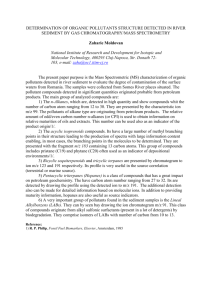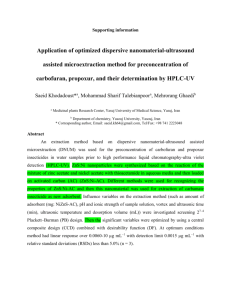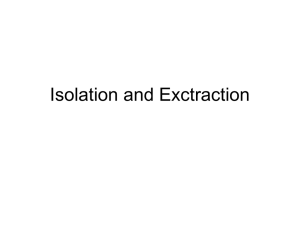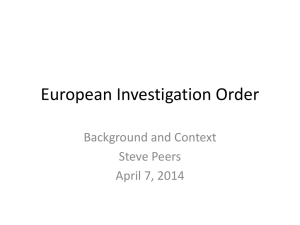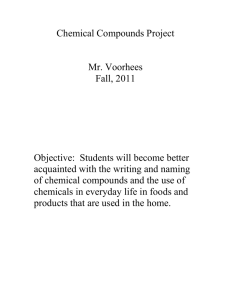jssc4467-sup-0001-SuppMat
advertisement
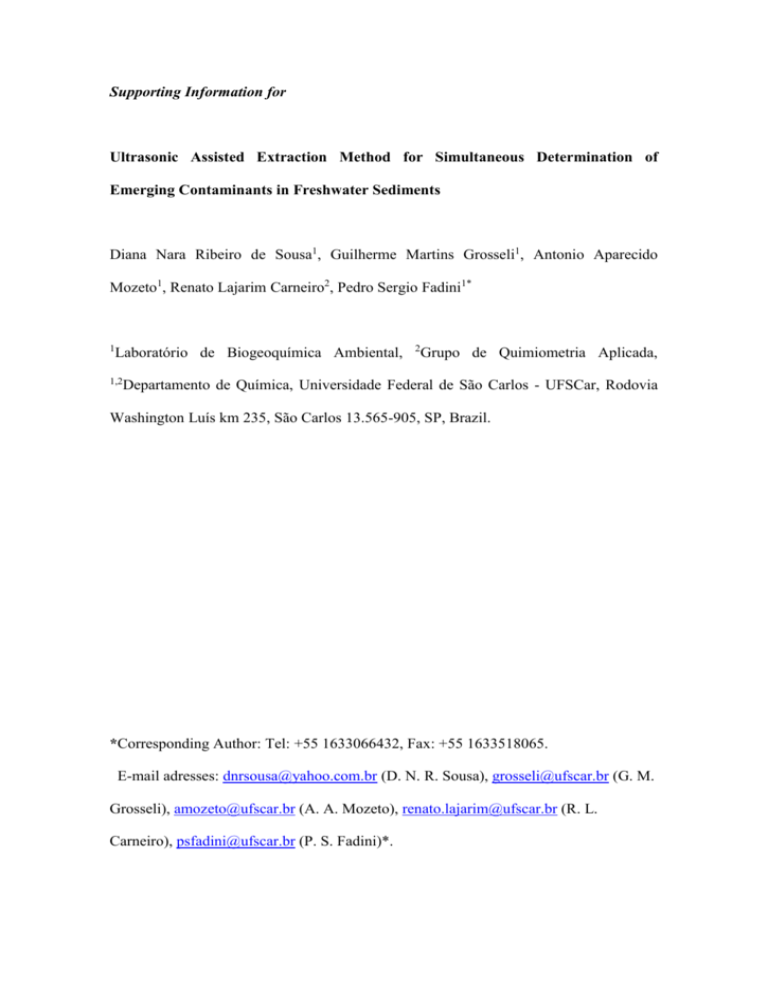
Supporting Information for Ultrasonic Assisted Extraction Method for Simultaneous Determination of Emerging Contaminants in Freshwater Sediments Diana Nara Ribeiro de Sousa1, Guilherme Martins Grosseli1, Antonio Aparecido Mozeto1, Renato Lajarim Carneiro2, Pedro Sergio Fadini1* 1 Laboratório de Biogeoquímica Ambiental, 1,2 2 Grupo de Quimiometria Aplicada, Departamento de Química, Universidade Federal de São Carlos - UFSCar, Rodovia Washington Luís km 235, São Carlos 13.565-905, SP, Brazil. *Corresponding Author: Tel: +55 1633066432, Fax: +55 1633518065. E-mail adresses: dnrsousa@yahoo.com.br (D. N. R. Sousa), grosseli@ufscar.br (G. M. Grosseli), amozeto@ufscar.br (A. A. Mozeto), renato.lajarim@ufscar.br (R. L. Carneiro), psfadini@ufscar.br (P. S. Fadini)*. Table of Contents Table S1. Characteristic of emerging contaminants studied. Table S2. Monitored conditions for analysis of the target compounds by UPLCMS/MS. Table S3. Characteristics of the analyzed sediment river samples. Table S1. Molecular structure and physical-chemical properties of emerging contaminants studied. Emerging Water Characteristics CAS Log a Compound Contaminant pKa Solubility number Kowa Use (mg L-1)a Atenolol 29122-68-7 0.16 9.6 13300 Basic β-Blocker Caffeine Stimulant 58-08-2 -0.07 10.4 21600 Neutral Carbamazepine Antiepileptic 3564-73-6 2.46 7.0 16.8 Neutral Diclofenac Antinflamatory 15307-86-5 4.51 4.15 2.37 Acidic Ibuprofen Analgesic and 15687-27-1 3.97 4.91 21.0 Acidic Antinflamatory Naproxen Analgesic and 22204-53-1 3.18 4.15 15.9 Acidic Antinflamatory Propranolol 525-66-6 3.48 9.42 61.7 Basic β-Blocker Triclosan Bactericide 3380-34-5 4.76 7.68 10 Acidic Estrone Hormone 53-16-7 3.13 10.3b 30 Basic b Hormone 50-28-2 4.01 10.3 3.6 Basic 17-β-Estradiol b 17-αHormone 57-63-6 3.67 10.3 11.29 Basic Ethinylestradiol a www.syrres.com b strongest acidic (www.drugbank.ca) Table S2. Monitored conditions for analysis of the target compounds by UPLC-MS/MS. Target compounds Analyzed in negative mode Naproxen Naproxen-d3 Ibuprofen Ibuprofen-d3 Diclofenac Diclofenac-d4 Estrone Estrone-d4 17-β-estradiol 17-β-estradiol-d5 17-α-ethinylestradiol 17-α-ethinylestradiol-d4 Triclosan Triclosan-d3 Rt window (min) 1.55 - 2.05 1.80 - 2.40 2.80 - 3.20 3.15 - 4.00 Analyzed in positive mode Caffeine 1.50 - 1.85 Caffeine-d3 Atenolol 1.85 - 2.25 Atenolol-d7 Carbamazepine 2.40 - 2.85 Carbamazepine-d10 Propranolol 3.20 - 3.70 Propranolol-d7 CV-CE: Cone Voltage-Collision Energy (eV). Precursor ion CV-CE MRM1 229 232 205.1 208 294 298 269.1 273.2 271.2 276.2 295.2 299.2 286.9 292.6 15-15 12-8 15-8 15-8 20-12 20-12 53-38 53-35 53-35 53-40 55-40 55-40 18-10 18-10 170.1 188 161.1 164 250.1 254 145.1 147 145.1 147 145 147 35 35 195 198 267 274 237.1 247 260.1 267.2 35-20 35-22 32-30 32-28 33-20 33-25 34-24 34-25 138.1 138 145 145 194.1 204 72 72 CV-CE MRM2 15-8 185.1 15-5 205.1 20-12 296>252 53-40 143 53-40 183.1 55-34 159 18-7 288.9>35 35-30 42 32-20 190 33-20 192 34-22 116 Table S3. Characteristics of the analyzed sediment river samples. Site S1 S2 S3 S4 S5 S6 TOC (%) ± SD 3.80 ± 0.38 0.49 ± 0.04 1.63 ± 0.04 0.88 ± 0.04 0.98 ± 0.04 2.34 ± 0.05 Clay (%) 30 22 35 30 18 37 Silt (%) 10 5 16 8 3 10 Sand (%) 60 73 49 62 79 53 TOC – Total Organic Carbon UPLC-MS/MS Analysis The chromatographic separation was performed with a reverse phase column Acquity UPLC BEH C18 (1.7 microns, 2.1 x 50 mm) equipped with a guard column of the same material, both obtained from Waters. Ultrapure water (0.05% NH4OH) and methanol were used as mobile phases in gradient elution mode, a flow rate of 0.45 mL min-1 and 10 μL of injection volume. Analysis were performed in positive and negative modes with capillary voltage 3000 V and 2500 V, respectively. The temperatures used were 500 °C for the desolvation gas and 150 ºC for the source block. Method Validation Samples were quantified by internal standard calibration with a mixture of water:methanol (75:25, v/v). A minimum eight-point calibration curves (0.1 – 400 μg L-1) were obtained using linear regression analysis, corresponding at concentration of 0.05 – 200 ng g-1. The concentration of each IS was fixed at 100 μg L-1 (50 ng g-1). The linearity was qualified by coefficient of determination (r2) in the linear regression. The recoveries of each compound were used to correct the final concentration sample. Analysis and data processing was performed using MassLynx 4.1 software with two transitions for each compound in the Multiple Reaction Monitoring mode (MRM). Recoveries were calculated based on the peak areas of the analytes in the spiked sediment at different steps of extraction. For calculation of the total recovery (Rec T), a sediment sample was spiked with a mixture of the target compounds and IS, both at 50 ng g-1, in triplicate (X). The spiked matrices were mixed in vortex for 30 s and keeping at -20 °C for 24 h to equilibration time. After that, the extraction was carried out according to procedure described in 2.3. In another tube, a sediment sample was extracted without spiking. At this sample, the mixture of the target compounds and IS was added just in reconstitution step (Z). RecT was obtained through the ration between peak areas for X and Z (Equation 1). SPE step recoveries (RecSPE) was calculated from an extract obtained from UAE step (without spiking) diluted in 250 mL of ultrapure water. In this solution was added a mixture of same compounds and IS (Y) and then carried out the SPE extraction. RecSPE was obtained through the ration between peak areas for Y and Z (Equation 2). UAE recovery (RecUAE) was calculated as the difference between RecT and RecUAE (Equation 3). These relationships are presented in Equations (1) to (3): 𝑋 𝑅𝑒𝑐𝑇 = ( ) × 100 𝑍 𝑌 𝑅𝑒𝑐𝑆𝑃𝐸 = ( ) × 100 𝑍 (1) 𝑅𝑒𝑐𝑈𝐴𝐸 = 100 − (𝑅𝑒𝑐𝑆𝑃𝐸 − 𝑅𝑒𝑐𝑇 ) (3) (2) The matrix effect (ME) was evaluated in terms of the suppression or increasing of signal according to Stahnke et al. (2011) [1]. This effect was calculated using Equation (4), where A corresponds to the peak area for standard solutions in solvent and B for the spiked sample after the total extraction from the sediments. Negative ME values represent analyte signal suppression and positive values denote matrix-induced enhancements. ME values close to zero are desirables, since this represents the non-occurrence of the ME. 𝐵 𝑀𝐸(%) = ( − 1) × 100 𝐴 (4) The overall precision of the method was evaluated at the level concentration of 50 ng g-1 of analyte and IS for each compound. These samples were extracted for three consecutive days, and for each day the extractions was carried out in triplicate. This sample is a mixture of different sampling days at same site, with different sampling condition. The ruggedness of the method can also be confirmed by this heterogeneous and complex sample. The precision was expressed as the relative standard deviation (RSD) of replicates measurements. The method limits of detection and quantification (MDL and MQL) were calculated using spiked samples that were submitted to UAE-SPE. These calculations were made according to Baker et al. (2011) [2], in equations (5) and (6), total recovery (RecT) and the concentration factor used in the SPE extraction (CF), were considered. Firstly, the instrumental detection limit and instrumental quantification limit (IDL and IQL) were calculated using the signal-to-noise ratio, from a sample that was submitted to UAE-SPE and spiked during the reconstitution. For the IDL we considered a signal-to-noise over than 3, and for the IQL a signal-to-noise over 10 was established for the first transition and over 3 for the second transition. CF used in this study was 250 and the recovery values at the concentration level of 50 ng g-1. 𝑀𝐷𝐿 = 𝐼𝐷𝐿 × 100 𝑅𝑒𝑐𝑇 × 𝐶𝐹 (5) 𝑀𝑄𝐿 = 𝐼𝑄𝐿 × 100 𝑅𝑒𝑐𝑇 × 𝐶𝐹 (6) References [1] Stahnke, H., Kittlaus, S., Kempe, G., Alder, L., Anal. Chem. 2012, 84, 1474-1482. [2] Baker, D. R., Kasprzyk-Hordern, B., J. Chromatogr. A 2011, 1218, 1620-1631.
